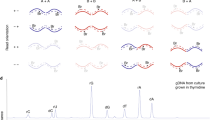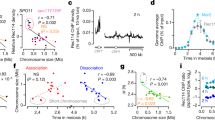Abstract
MITOTIC sister chromatid exchanges (SCE) are currently the subject of research and controversial discussion1,2. In contrast, there is uncertainty as to whether this type of exchange ever occurs in meiotic chromosomes, but cytological studies on ring-rod heterozygotes in Zea3 and Antirrhinum4 certainly suggest that sister as well as non-sister crossovers occur during meiosis. A few direct attempts at this problem have been made using the technique of tritium autoradiography5–7, but by and large the results have proved inconclusive. The detection of meiotic exchanges by this method depends on the fact that germ line chromosomes, like those of somatic cells, replicate in a semi-conservative manner. Thus chromosomes labelled with 3H-thymidine during the pre-meiotic S-phase enter meiosis with both chromatids labelled, while chromosomes labelled one cell cycle earlier, that is, during the S-phase of the last gonial mitosis, enter meiosis having one labelled and one unlabelled chromatid. This system clearly provides an opportunity to test for the occurrence of sister chromatid exchanges in meiotic chromosomes using procedures analogous to those widely applied to mitotic chromosomes. On a simple view this would involve the detection of label switches involving sister chromatids, but in practice the situation is far more complex and the detection and estimation of meiotic SCEs are made difficult by a number of complicating factors. The most obvious of these is the occurrence of another class of exchanges in meiotic cells, namely, the crossovers which involve non-sister chromatids of homologous chromosomes. The most irritating feature of these crossovers is that in suitable combinations they can mimic the effect of SCE by producing label switches which are reciprocal between sister chromatids of AI or MII chromosomes (see Fig. la). This fact led Taylor5 to conclude that “… when exchanges are observed they cannot readily be classified as SCEs or as crossovers”. The results presented here permit a more optimistic view of the situation.
This is a preview of subscription content, access via your institution
Access options
Subscribe to this journal
Receive 51 print issues and online access
$199.00 per year
only $3.90 per issue
Buy this article
- Purchase on Springer Link
- Instant access to full article PDF
Prices may be subject to local taxes which are calculated during checkout
Similar content being viewed by others
References
Geard, C. R., and Peacock, W. J., Mutation Res., 7, 215 (1969).
Heddle, J. A., Mutation Res., 6, 57 (1968).
Schwartz, D., Genetics, 38, 251 (1953).
Michaelis, A., Chromosoma, 10, 144 (1959).
Taylor, J. H., J. Cell. Biol., 25, 57 (1965).
Moens, P. B., Chromosoma, 19, 277 (1966).
Callan, H. G., and Taylor, J. H., J. Cell. Sci., 3, 615 (1968).
Author information
Authors and Affiliations
Rights and permissions
About this article
Cite this article
JONES, G., CRAIG-CAMERON, T. Analysis of Meiotic Exchange by Tritium Autoradiography. Nature 223, 946–947 (1969). https://doi.org/10.1038/223946a0
Received:
Issue Date:
DOI: https://doi.org/10.1038/223946a0
This article is cited by
-
BrdU-dye characterization of late replication and meiotic recombination in Armenian hamster germ cells
Chromosoma (1979)
-
The analysis of exchanges in tritium-labelled meiotic chromosomes
Chromosoma (1971)
-
The analysis of exchanges in tritium-labelled meiotic chromosomes 1. Schistocerca gregaria
Heredity (1970)
Comments
By submitting a comment you agree to abide by our Terms and Community Guidelines. If you find something abusive or that does not comply with our terms or guidelines please flag it as inappropriate.



